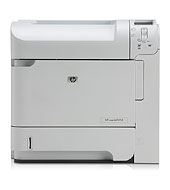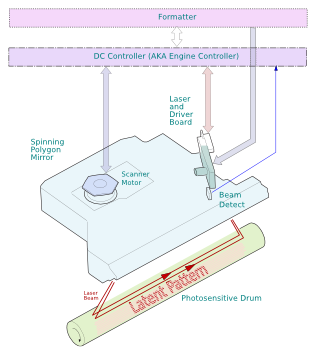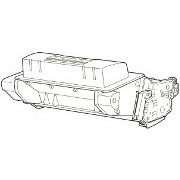HP Original Cartridges
Reliable Remanufactured Cartridges
One of the merits of the P4014 against a new printer is the low cost of good re-manufactured cartridges.
At the moment we don't sell in the US, but we hope to soon
Error Message 51 for HP P4014, P4015 and P4515 Series Printers.
Error 51 is an issue with the laser-scanner. The scanner has a dual-beam laser semiconductor. The scanning action is created by a polygon mirror mounted on a fast-spinning motor. The laser drive chip can report problems with the laser itself. There is a beam detector at one side of the scan and if it fails to detect the beam that is reported as an error.

51.xy LASER SCANNER ERROR
51.xy Laser Scanner Error. Sometimes this may be "51.xy" PRINTER ERROR FOR HELP PRESS ? alternates with TO CONTINUE TURN OFF THEN ON". The error is generated by a fault in the laser scanner. With luck, it may prove to be a temporary error message; turn the power off and then on. If the error recurs, run thediagnostics menu laser scanner motor component test and listen for the motor noise. If the test fails or the error persists HP say to check connectors J86 and J93 on the DC controller.
According the the service manuals the P4014 series printers don't have "52 error" in their repertoire, and those faults seem to have been subsumed under this heading. Historically "51" was the laser and "52" was the polygon mirror motor but they are associated and the likely answer to both is to replace the whole assembly RM1-5465 / RM17419.

About the Laser Scanner
The laser scanner is the item that gives laser-printers their name. The laser itself is a semiconductor infra-red device not unlike those in DVD players. One key difference is that in the P4010 series (and M600) the laser is dual beam.
The laser is made to scan using a disk whose circumference is made up of several mirrors. (To be a bit trite, it is similar to a mirrored disco ball but there are only a couple of laser-lamps and just six mirror facets). The polygon mirror is mounted on a motor shaft and rotates rapidly.
In these printers (and most laser printers) the laser writes black. The precharge roller puts a charge on the drum that repels toner, the toner sticks where the laser discharged it. Outright laser failure would result in white pages if no error were reported.
The laser scanner has to work very quickly. Set to do 1200dpi at full speed it would need to scan 13200 lines in less than a second, but those dual beams presumably halve that to 6600. The service manual shows the mirror as 6 sided so one rotation provides 6 scan lines but that still leaves the motor needing to spin 1100 times in a second - or 66,000 rpm.
The laser diode(s) are mounted to one side of the mirror and focussed through a colimation lense. Semiconductor laser beams are not naturally collimated. The beam emerges from a cleaved facet of a chip so a copuple of lenses provide colimation and focus. After reflection from the polygon mirror the beam is re-focussed by a lense before being aimed down at the drum by one or more mirrors.
The laser scanner unit looks like a fairly simple black box but contains some fairly subtle engineering.
Error 51 Details
The "51.X Error" can be followed by one or two digits:
- 51.10 means beam detect malfunction
- 51.20 means laser error.
Mono laser printers are likely to go to error only when they are asked to actually print something. Most cycle the cartridge components at startup to make sure freshly charged toner is available, however they aren't asked to print, so they don't run the laser or polygon mirror.
Colour printers need to calibrate as they start up (they print on the belt to do this) so they could give this error or its partner the "52 error" during the initial self test.
The P4014 is a mono printer so it should say either "51.20" or "51.2K". Just in case you land on this page but have an error on a colour printer the code "51.2C" would mean "laser error cyan". The subcodes for colours are the letters C=Cyan, M=Magenta, Y=Yellow, K=Black an 0=No colour.
Beam detect is an opto-detector at one end of the laser travel across the exit mirror. The purpose is to get precise timing and confirm that the laser mechanism is working. Some printers also have a flag on the shutter that will get in the way of the beam if the cartridge fails to open it. It may be handy to use beam detect in this way but is could be misleading.
Laser beam error may be feedback from the laser-diode control board. Laser diodes are not quite straightforward, they have a half-life about 20,000 hours in the same way that LEDs do, but this is compensated by a backfacet diode detecting the light and working a feedback circuit. Laser output is also quite sensitive to heat and the electrical input needs to be adjusted for this as well. The circuit board on the back of the laser unit deals with keeping the laser in trim.
Laser scanning provides a bit of a mechanical challenge. OKI and Kyocera chose to abandon it for solid-state LED arrays many years ago and Brother seem to be joining them. Packing thousands of LEDs into an 8 inch strip poses its own challenges. However laser scanning is supposed to be reported by a 52 Error. Experience suggests that a few printers are prone to the scanner freezing (more below).
Laser diodes will ultimately fail but we know of HP 4L printers from 1993 still operating and they are over 20 years old - so it is possible for lasers and scanners to last a long time.
Remedies
Beam detect errors seem likely to be a fault with the laser-diode itself or its drive circuitry on the board mounted on the back of the scanner unit. It could be polygon mirror. The path from computer to page is: computer, - driver, - print-language, - formatter, - DC-Controller, - laser-data cable, - laser control board, - laser-chip, - polycom mirror, - optics, - drum. This fault can come anywhere from the DC-controller through to the optics. In some designs it could potentially be the laser shutter.
It is difficult to verify operation of the laser in a printer, other than by getting it to print. The laser is buried deep inside the printer facing into the cartridge, protected by a safety switch and the shutter. The beam is invisible infra-red but could damage human eyes, hence the need for the shutter.
It would be possible to verify the data going to the laser with a high-speed oscilloscope or logic probe. The data signals are on twisted-pair wires because the signal is high frequency (about 127 MHz).
It would certainly be possible to meter the output of the laser using a photo-sensor but doing so on a printer requires changes in the works. A test-rig would probably be needed to test laser units out of circuit and there isn't sufficient volume of failed units to justify it.
If the page image is coming up all black or all white then one way to test what the laser is doing is to put a strip of brown tape over a bit of the cartridge laser window, just to see if the image changes across that stripe. Since the laser in these printers writes black, if the laser is blocked or fails we get plain white pages.
Components for the laser scanner are not available, from HP just the complete unit. The dual-beam laser diode is presumably specially made for laser printers and there are several patents for circuitry to balance the beams. The laser unit on a printer is factory aligned, so it wouldn't be easy to fix without a factory jig. New laser units cost about £250 which is probably near the limit of what people are prepared to pay for spares for this printer. We think "refurbed" (good pull) scanners will generally be about £70.
Laser scanner units are sold as units but some points are repairable.
Engineers quite commonly open the laser unit and clean the optics. We don't thing dirty optics will give a "51 error" - rather it will give inadequate contrast and light print,
If the laser unit is opened it is worth testing the polygon mirror unit to see that it rotates freely. If it does not there is an issue. It is possible to dismantle polygon mirror assemblies, they are usually held by a couple of E-rings. Lift the polygon mirror and it's shaft out of the bushing, clean both shaft and bushing with alcohol (isopropyl or IPA) and then re-lubricate the bushing with a couple of drops of machine oil. This will often get more life from a scanner however we think that goes somewhat beyond the remit of the average technician. Faults with the scanner should also give a"52 error"; not 51 which we are dealing with here.
Other things to look for are dirty optics. Don't touch the mirrors and lenses in the laser assembly with fingers, use a cotton bud or suchlike and wipe them gently with IPA. Sometimes the mirrors are surprisingly dirty. Note that the mirrors are silvered on the outside of the glass to give them maximum reflectivity but that does make them vulnerable to scratches.
Web Research
I tried querying Google with P4015 "51 ERROR"
in quotes and got a suggestion of About 1070 results
; implying a little known topic.
- fixya gives one half-correct answer (the fault is RM1-5465), one wrong C2037-69008 and one complete rubbish suggesting its a paper jam.
- charter.net Generic HP errors web page that says it dates from 1997 and judging by the printers it lists that is true - completely out of date.
- mj-printers colourful text page but yet again rather out of date. No printers more recent than the LJ-4100 which is more than ten years ago.
- fixyourownprinter is normally reliable, but yet again this page is just a gereic error messages page for the HP range and seriously out of date - the most recent printer is the 6P !
- electronicwerkstatt.de once again, terribly out of date.
- pilchuk.com a page I hadn't seen before with some good advice on changing catridges before calling an engineer - and a little bit on the "51 Error" for the SX engine (HP II, III, IID,IIID etc). Elsewhere on the site he says he hasn't updated it since 1997. Why is this query getting nothing but the extremely dated? I could use the Wayback machine for that!
- Long URL giving a PDF of the Printer Job Language Technical Reference Manual. Scarcely relevant.
- hp.com LaserJet 4600 and 4650 Series Printers - Numerical Printer Messages. Not directly relevant to the query but confirms that the same message is used.
- marketpoint.com Very interesting blog and a few articles relevant to the fault
- irrelevant database of medical information. Accidental correspondence to a search key.
- workoffice.ru LaserJet II /III faults on a Russian language site.
- helpowl offering irrelevant bits from the HP LJ 4 service manual
- blogspot.co.uk Large heap of irrelevant and dubious fixes for unrelated printers presumably culled from somewhere as a way to sell a cartridge chip resetter.
After that there a couple more irrelevances and the repeat the search
message. The search turned up one gem in the marketpoint blog which is good.
Copyright G & J Huskinson & MindMachine Associates Ltd 2013, 2015. Some pictures derived from HP User and Service guides. These technical pages do not constitute an offer for sale; just our knowledge at the time of writing. See the catalogue. Sales pages on this Web site use cookies to store user information. We also use Google Analytics to track site usage patterns.

